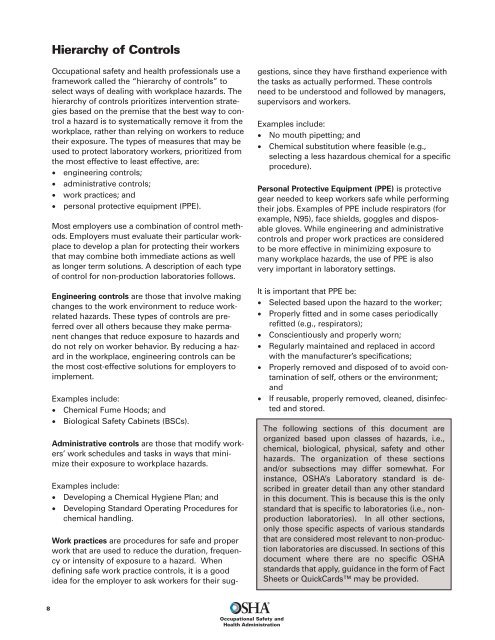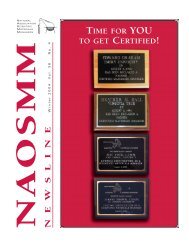Laboratory Safety Guidance
OSHA Lab Safety Guidance - ORS Optical Remote Sensing ...
OSHA Lab Safety Guidance - ORS Optical Remote Sensing ...
- No tags were found...
You also want an ePaper? Increase the reach of your titles
YUMPU automatically turns print PDFs into web optimized ePapers that Google loves.
Hierarchy of Controls<br />
Occupational safety and health professionals use a<br />
framework called the “hierarchy of controls” to<br />
select ways of dealing with workplace hazards. The<br />
hierarchy of controls prioritizes intervention strategies<br />
based on the premise that the best way to control<br />
a hazard is to systematically remove it from the<br />
workplace, rather than relying on workers to reduce<br />
their exposure. The types of measures that may be<br />
used to protect laboratory workers, prioritized from<br />
the most effective to least effective, are:<br />
• engineering controls;<br />
• administrative controls;<br />
• work practices; and<br />
• personal protective equipment (PPE).<br />
Most employers use a combination of control methods.<br />
Employers must evaluate their particular workplace<br />
to develop a plan for protecting their workers<br />
that may combine both immediate actions as well<br />
as longer term solutions. A description of each type<br />
of control for non-production laboratories follows.<br />
Engineering controls are those that involve making<br />
changes to the work environment to reduce workrelated<br />
hazards. These types of controls are preferred<br />
over all others because they make permanent<br />
changes that reduce exposure to hazards and<br />
do not rely on worker behavior. By reducing a hazard<br />
in the workplace, engineering controls can be<br />
the most cost-effective solutions for employers to<br />
implement.<br />
Examples include:<br />
• Chemical Fume Hoods; and<br />
• Biological <strong>Safety</strong> Cabinets (BSCs).<br />
Administrative controls are those that modify workers’<br />
work schedules and tasks in ways that minimize<br />
their exposure to workplace hazards.<br />
Examples include:<br />
• Developing a Chemical Hygiene Plan; and<br />
• Developing Standard Operating Procedures for<br />
chemical handling.<br />
Work practices are procedures for safe and proper<br />
work that are used to reduce the duration, frequency<br />
or intensity of exposure to a hazard. When<br />
defining safe work practice controls, it is a good<br />
idea for the employer to ask workers for their sug-<br />
gestions, since they have firsthand experience with<br />
the tasks as actually performed. These controls<br />
need to be understood and followed by managers,<br />
supervisors and workers.<br />
Examples include:<br />
• No mouth pipetting; and<br />
• Chemical substitution where feasible (e.g.,<br />
selecting a less hazardous chemical for a specific<br />
procedure).<br />
Personal Protective Equipment (PPE) is protective<br />
gear needed to keep workers safe while performing<br />
their jobs. Examples of PPE include respirators (for<br />
example, N95), face shields, goggles and disposable<br />
gloves. While engineering and administrative<br />
controls and proper work practices are considered<br />
to be more effective in minimizing exposure to<br />
many workplace hazards, the use of PPE is also<br />
very important in laboratory settings.<br />
It is important that PPE be:<br />
• Selected based upon the hazard to the worker;<br />
• Properly fitted and in some cases periodically<br />
refitted (e.g., respirators);<br />
• Conscientiously and properly worn;<br />
• Regularly maintained and replaced in accord<br />
with the manufacturer’s specifications;<br />
• Properly removed and disposed of to avoid contamination<br />
of self, others or the environment;<br />
and<br />
• If reusable, properly removed, cleaned, disinfected<br />
and stored.<br />
The following sections of this document are<br />
organized based upon classes of hazards, i.e.,<br />
chemical, biological, physical, safety and other<br />
hazards. The organization of these sections<br />
and/or subsections may differ somewhat. For<br />
instance, OSHA’s <strong>Laboratory</strong> standard is described<br />
in greater detail than any other standard<br />
in this document. This is because this is the only<br />
standard that is specific to laboratories (i.e., nonproduction<br />
laboratories). In all other sections,<br />
only those specific aspects of various standards<br />
that are considered most relevant to non-production<br />
laboratories are discussed. In sections of this<br />
document where there are no specific OSHA<br />
standards that apply, guidance in the form of Fact<br />
Sheets or QuickCards may be provided.<br />
8<br />
Occupational <strong>Safety</strong> and<br />
Health Administration



